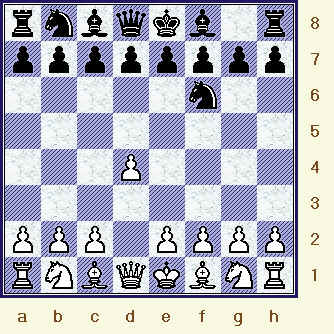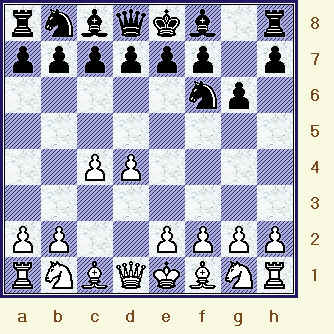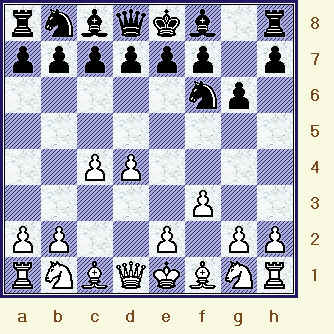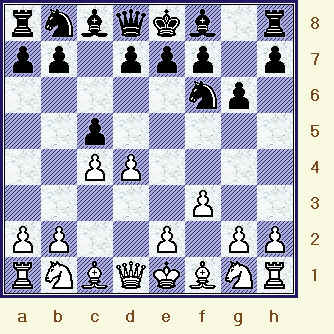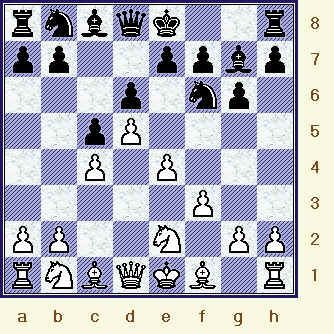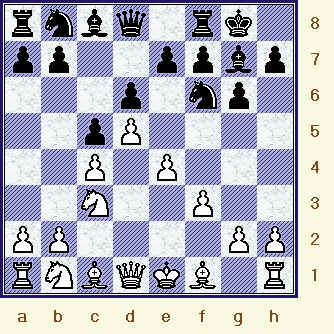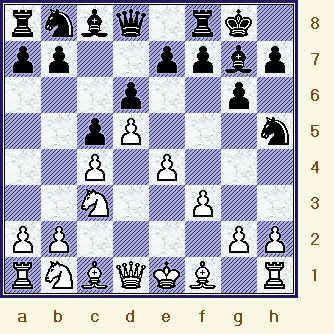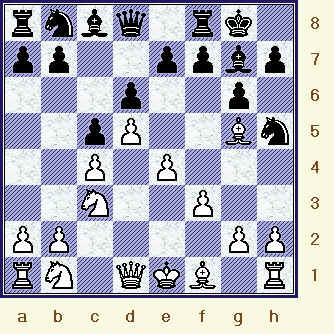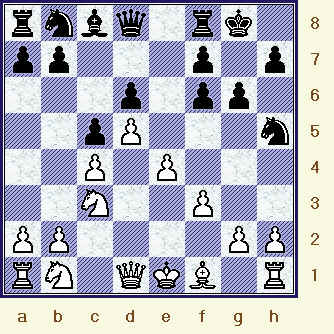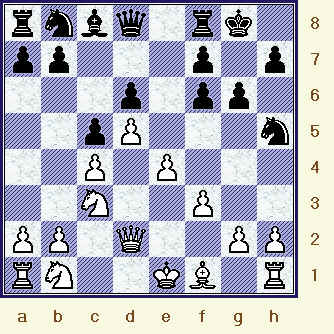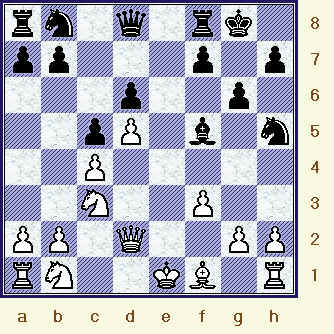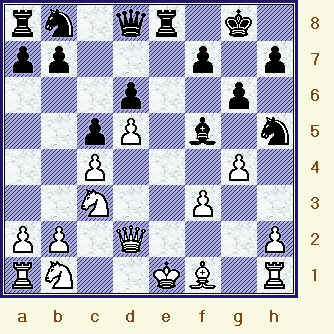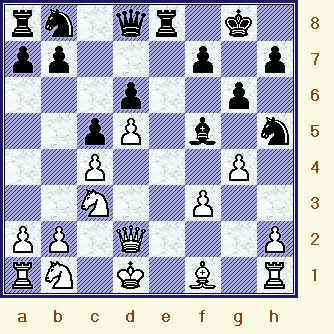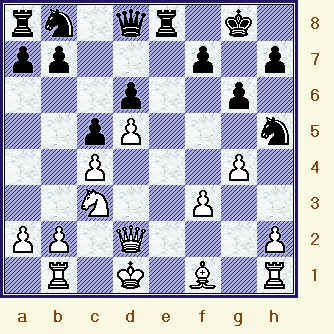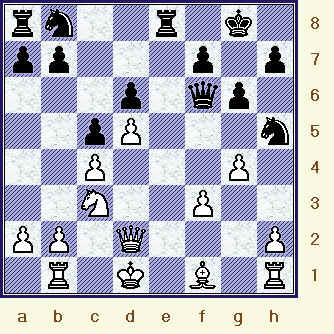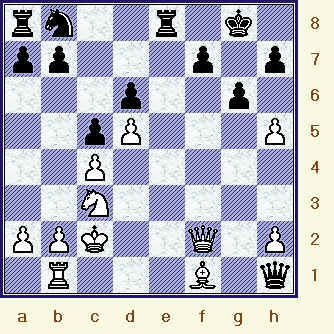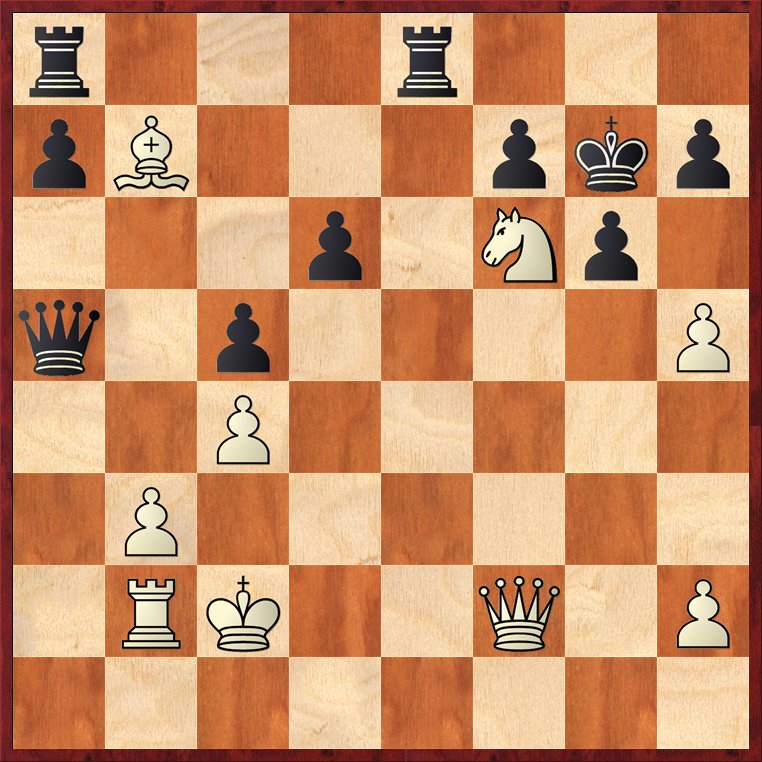All
the |
(Navigation bar
directly below.)
*******
© A.J. Goldsby, 2015.
(All rights reserved.)
****************
Click HERE
to see my
Chess Items.
****************
****************
Buy a book
from Amazon.com
(And help me out as well!)
****************
Click HERE
...
to see a list of the businesses that help to sponsor all of
my chess efforts.
|
|
|
Click HERE to see an explanation of the symbols that I commonly use when I annotate any chess game. Click HERE
to replay this game ... on another server. Click HERE to see my video channel on the "You-Tube" channel. (Click HERE to see my video on this game.) The ChessBase coverage of this game is excellent, there are three different analysis that you can download and study. Additionally, there are at least two video's that you can watch ... AND you can watch the entire video stream of the whole of the eighth game! Click HERE. ******************************************************************************************************************************* Thus far in this match, The first six games were all drawn. Then, in Game Seven, Gelfand broke through to win. Now Anand was under the gun, how would he respond?
|
Viswanathan
Anand
(2799) - Boris
Gelfand
(2739)
|
|
|
[A.J. Goldsby I]
A miniature ... and at the World Championship level! (Not since the days of Morphy has such a thing occurred ...)
As soon as the game was finished, I knew that I would be adding it to my collection of short games!
***************************************************************************************************************************************************************
1.d4 Nf6; (development)
The same opening as games #1 and
#3 of this match.
(In game #5, Anand played 1.e4, and Gelfand countered with 1...c5; and the
Sveshnikov Sicilian was the opening that day.)
|
|
rnbqkb1r/pppppppp/5n2/8/3P4/8/PPP1PPPP/RNBQKBNR w KQkq - 0 2
To me ... matches like this are very exciting. ("Who will be the first to blink?")
2.c4 g6; (fianchetto)
Once more, Gelfand shows his preference for a Grunfeld/KID type of pawn structure. In this regard, Gelfand is greatly different from many other players (like,
say GM V. Kramnik) who prefer to answer 1.d2-d4, with 1...d7-d5.
|
|
rnbqkb1r/pppppp1p/5np1/8/2PP4/8/PP2PPPP/RNBQKBNR w KQkq - 0 3
Ideas like 1...Nf6; and 2...g6; are known as "hyper-modern openings."
(Prior to the 1930's, most masters nearly always opened 1.e4, e5; or 1.d4, d5.)
3.f3!?, "The Anti-Grunfeld"
As in Game
Three, Anand seems to be trying to discourage Black from playing 3...d7-d5.
(A. Alekhine usually gets the credit for 3.f3!?, having played it against Bogo. However, GM
Salo
Flohr was the first to discover this move, writing - in a
newspaper article - that 3.f3 might be playable. And he even used it in a game before anyone else did ... playing it first in a simul and then in a tournament game in
1929.)
|
|
rnbqkb1r/pppppp1p/5np1/8/2PP4/5P2/PP2P1PP/RNBQKBNR b KQkq - 0 3
The (normal) "book" move here would have to be 3.Nc3, and this would lead to the main lines of the
Grunfeld after 3...d7-d5; or to a
King's Indian Defense
after 3...Bg7.
[ Of course, 3.Nc3 d5; is - The Grunfeld Defense. (See Game # 1 of this match.) ]
Now Gelfand tries a new move ... at least for him, in this match.
3...c5; ('!')
(King's
Indian/Benoni)
Gelfand is the first to vary from the paths of their previous games. (For 3...d5; see
game #
3. Analysis
of game three.)
|
|
rnbqkb1r/pp1ppp1p/5np1/2p5/2PP4/5P2/PP2P1PP/RNBQKBNR w KQkq c6 0 4
Now the terrain has been set, White should play on the Q-side, and Black on the King-side.
( "You always play on the side of the board where you have more space."
- Siegbert Tarrasch
{Tarrasch was one of the greatest chess teachers/writers ... of all
time; he was also a strong player as well.}
Search
Google for S. Tarrasch; at the bottom of this page,
is a brief bio - that I did - on this player. )
[ Black could also play:
RR 3...e5!?;
- GM Peter Leko.
4.dxe5
Nh5; "<=>" (counterplay)
when Black has piece play and definite compensation for the sacrificed Pawn.
[ See MCO-15, page # 645, all columns and note # (a.) ]
Reference - the contest:
GM
Vladimir Kramnik (2780) - GM Petar Leko (2665);
[E60]
ICT,
Fontys, Round # 06 /
Tilburg, NED / 29,10,1998.
{Black won a very tough struggle, 0-1 in 45 moves.} [replay]
******************************************************************************************************************
The "main line" (instead of 3...c5!?) would probably have to be the following topical variation:
3...d5; 4.cxd5 Nxd5; 5.e4 Nb6; 6.Nc3 Bg7; 7.Be3, "~" (unclear, maybe +/=)
with possibly a small plus for White ... the results in the DB, (from this particular position);
definitely seem to favor the first player here.
[ See MCO-15, page # 645, all columns and esp. note # (a.) ]
Reference the hard-fought struggle:
GM Viswanathan Anand (2817) - GM
Shakhriyar Mamedyarov (2746); [D70]
The 15th Corsica Masters (rapid) /
Bastia, FRA; (R# 4.1) / 31,10,2011.
{White won a sharp
game, 1-0 in a total of 43 moves here.}
******************************************************************************************************************
Instead, after the moves of:
3...Bg7; 4.e4 d6; 5.Nc3
0-0; 6.Be3, "+/=" (White is slightly better.)
we transpose into the main lines of the Samisch System, (of the King's Indian
Defense).
[ See MCO-15, beginning on page # 588. ]
A good - relatively recent - high level confrontation would be:
GM Viswanathan Anand (2791) - GM
Alexander Grischuk (2733); [E84]
ICT, 26th
Super-GM;
Round. # 07 /
Linares, ESP; 26,02,2009.
{The game was
a fairly well played
draw, 1/2 in 32 moves.}
]
Naturally, White gains some space by pushing his d-Pawn forward to d5.
(The next few moves are fairly natural, and should require no explanation - both sides continue to follow the
basic principles
that apply to the opening phase of the game of chess.)
4.d5 d6; 5.e4 Bg7;
6.Ne2!?, (hmmm)
What in the world?!?!?
|
|
rnbqk2r/pp2ppbp/3p1np1/2pP4/2P1P3/5P2/PP2N1PP/RNBQKB1R b KQkq - 0 6
Don't bother trying to find this opening/position in your MCO (or any other
openings'
reference work) ... ... ...
I think you will be wasting your time!
Actually, I think that this is White's way of saying - given the current pawn structure - that his Knight BELONGS on the Q-side, where the first player has more "elbow-room" ... to move around in. (It may also be directed at Black's ...e7-e6 pawn break, in this way, both of White's Knights can cover the d5-square. Another point is after Black plays ...e6; and then ...exd5; White can play cxd5. In that case, then the other Knight has an easy development of N/b1-a3-c4. Yet another point might be that - in many lines of the Samisch, White has to re-deploy his KN from the e2-square, so maybe it might be best to go ahead and do this now - and not wait.)
And ... BELIEVE IT OR NOT ... this has all been played before!
[ See the game:
GM Matthew Sadler (2667) - GM
Vladislav Tkachiev (2634); [B07] /
3rd Enghien les Bains (Round # 02) /
Paris, France / 04,03,1999.
---> {Black won a tough
game, 0-1 in 44 total moves.} ]
[ According to the "Power-Book," a better line for White would have been
the following (very sharp) continuation:
6.Nc3 0-0; 7.g4!?, "+/=" when White has a big space advantage, and if
Black is not careful,
he can quickly get a bad position.
(Conversely, White is behind in development, if Black can somehow open things up ...)
See the contest:
GM Mihail Marin (2485) - IM Rico
Mascarinas (2465); [A65]
The FIDE Interzonal, (Round. #08) /
Manila, Philippines; 1990.
{White won a sharp game here, 1-0 in only 27 total moves!} ]
The computer engines already slightly favor Black ... although it is only around a quarter of a point here.
Naturally, Black castles here, with a nice lead in development. (And then Fritz 13 prefers the move of 7.Nf4, for White.)
6...0-0; 7.Nec3, (hmmm)
Perhaps this move was a surprise for Gelfand, he looked somewhat puzzled after Anand played it.
|
|
rnbq1rk1/pp2ppbp/3p1np1/2pP4/2P1P3/2N2P2/PP4PP/RNBQKB1R b KQ - 0 7
Possible (White) observations:
POSITIVE: "I have a fairly large edge in space in this position."
NEGATIVE:
"I am 2-3 tempi BEHIND in my overall development, as compared to other lines of the King's Indian."
[ Obviously, White could have also played: RR 7.Nbc3, here.
Reference the high-level contest:
GM
Viswanathan Anand (2811) - GM Hikaru Nakamura (2758); [E81]
ICT, The 6th Tal Memorial; (Round #8) / Moscow,
Russia; 24,11,2011.
{A well-played game ... drawn; 1/2-1/2 in a total of 33 moves.}
[Replay,
on the CG
website.] ]
Now Black has a wide choice of moves in this position. (He can try ...a6; ...Na6; ...e7-e6; ...Nd7; etc.)
7...Nh5!?; (TN)
According to the official website, this move is already a novelty, (A new move.); for Black.
|
|
rnbq1rk1/pp2ppbp/3p2p1/2pP3n/2P1P3/2N2P2/PP4PP/RNBQKB1R w KQ - 0 8
Black's idea is, since he is ahead in development, to play ...f7-f5; and open the game as quickly as possible.
(This is all probably good, sound chess thinking.)
There is one major problem for Gelfand's idea here, is that ...Nh5; invites White to play g2-g4.
[ Black had two other ways to go from here, both were pretty good for the second player.
***** ***** ***** ***** ***** ***** ***** ***** ***** ***** ***** ***** ***** ***** ***** ***** ***** ***** ***** *****
Alt. # 7B-01a.)
7...e6; (open lines)
This would probably have to be considered the main line (here) for Black.
8.Be3 exd5; 9.cxd5 a6; 10.a4, "+/=" (White is just slightly better.) 10...Nbd7; "<=>" (counterplay)
when White has an edge, but the computer shows many ways for Black to get a fairly good game.
IM Didier Leroy (2286) - NM
Ian Snape (2219);
[E60]
Master's Open
(Round # 9) / Hastings,
ENG; 05,01,2009.
[replay]
{White played a nice game, that culminated in a sharp attack, 1-0 in 41 moves.
However, I should point out that a brief computer analysis shows many ways for
Black to improve over this game.}
***************************************************************************************************************************
Alt. # 7B-01b.)
Black could have also played:
7...Na6; 8.Be2 Nc7; 9.Be3
a6; 10.a4, "+/=" (White has a small, but
solid edge.) 10...Rb8;
when White has an edge, but Black had pretty good play.
GM Viktor Laznicka (2596) - GM
Rainer Polzin (2480);
[E60]
National Team /
Bundesliga 0607 Germany,
(Round # 12.1) / 17,03,2007.
[replay]
{Black won, 0-1 in 38 moves.}
]
Now - on a routine or passive move by White - Black probably could play ...e7-e5; and then break with his f-Pawn and have a pretty good game.
8.Bg5, ('!') (restriction)
As mentioned previously, Black would like to advance his e-pawn and then play ...f7-f5; so naturally White works hard to try and prevent all of this from
happening. (Of course, with a BN on h5, White must be concerned about a possible/eventual
...Qh4+; as well.)
|
|
rnbq1rk1/pp2ppbp/3p2p1/2pP2Bn/2P1P3/2N2P2/PP4PP/RN1QKB1R b KQ - 0 8
The only real drawback - that I could see - to Bg5 is that it invites Black to play a quick 8...h7-h6.
[ White could have tried the more routine idea of Be3, but apparently this would not have lead to much:
RR 8.Be3
Qb6!; 9.Na4 Qa6!?; "~"
(unclear) - Fritz
13.
(Black has the plan of ...Nd7-b6; with good play from this position.)
]
Now the various engines are suggesting either 8...Na6!?; 8...Nd7; (or even the try of 8...h6!?); for Black in this position, and the first two of these options look very good to me.
[ Black probably swaps the diagonal-strikers for two reasons:
A.) He is ahead in development, but still a little cramped.
B.) After the exchange, White's dark squares are woefully weak. ]
(The main drawback to this exchange is that the Bishop on g7 is one of my favorite pieces, Black's position may lose a little of its energy here. Of course, Black probably would not be able to try and exploit the dark squares without this exchange. So - in a deep analysis, as compared to a superficial one - it becomes obvious that, while this may not have been my favorite plan, the engines find no real fault with it, either ... the resultant positions are all pretty close to equal.)
8...Bf6!?; 9.Bxf6 exf6!?;
Okay, hold the phone, is Black really content to double his own King-side Pawns here?
|
|
rnbq1rk1/pp3p1p/3p1pp1/2pP3n/2P1P3/2N2P2/PP4PP/RN1QKB1R w KQ - 0 10
I guess the idea is to open the e-file for Black and to use the Pawn on f6 as a battering ram to tear down White's big center with an eventual ...f7-f5.
(9...exf6!? causes the engine to go a little nuts here, the warning light comes on, and the "eval's" jump by over half a point. However, if you give it a few minutes, everything settles down, White only has a modest edge.)
[ Or RR 9...Nxf6; 10.Be2, "=" when White might have a slight edge here, but its certainly not much! ]
10.Qd2, (positional)
After yesterday's fiasco, Anand seems to be playing it slow and safe, while Gelfand seems absolutely determined to try and mix things up a bit.
|
|
rnbq1rk1/pp3p1p/3p1pp1/2pP3n/2P1P3/2N2P2/PP1Q2PP/RN2KB1R b KQ - 0 10
White's move controls the dark squares, and possibly prepares Na3 and 0-0-0, should events dictate that the first player's leader should leave the center as quickly as possible.
[ All the engines seem to be pointing out that White should have played the sharp g2-g4!
For example: >/= 10.g4! Ng7;
(Forced?)
This looks like the most prudent move for Black, any exchanges seem to aid White, and its the first choice of Houdini ...
when running on the official website.
( Or Black could try: (</=) 10...Nf4!?;
11.Ne2 Nxe2; 12.Bxe2 Nd7; 13.Nc3, "+/="
when White has a modest edge, however, its tough to come up with a good plan for Black.
)
11.Qb3, "+/=" -
Fritz 13.
when most of the really good engines are showing a slight edge here for White.
(No games - at all - for this position, not in any database.)
White could also play 11.Qe2, Nd2, and then 0-0-0 ... going for an all-out attack on the Black King. ]
Now Gelfand continues with his plan, which was to play ...f7-f5.
(To fail to do so, would be to willingly accept a passive position - at the highest levels, that is a recipe for disaster!)
Although I must admit that Fritz 13 likes 10...Nd7; and only shows a small (but solid) edge for White in this case.
Meanwhile, Anand also does not shy away from the indicated course of play, which is to play 11.exf5, ('!') and open the e-file, even though this causes some
problems for his own King.
10...f5; ('!') 11.exf5 Bxf5;
This looks like the simplest answer, although, at this point, Black had MANY ways to go.
|
|
rn1q1rk1/pp3p1p/3p2p1/2pP1b1n/2P5/2N2P2/PP1Q2PP/RN2KB1R w KQ - 0 12
Several engines suggest the sharp pawn-sacrifice of 11...Nd7!?; Black could have also played 11...Re8+; here as well.
[ One strong engine (Fritz 13) looks at the variation:
11...Qh4+; 12.Kd1 Bxf5; 13.g4
Bxb1; 14.Rxb1 Ng7; 15.Kc2, "~"
(unclear)
and Houdini evaluates this as
nearly equal. However, I (very strongly!) feel that
this position is ultra-sharp, and that one false step - by either player!!! - could be fatal.
]
(Now GM V. Anand does not shy away from the best move, although it could be dangerous for him, and it sharpens the struggle here ... quite a bit.)
12.g4!, "+/="
12...Re8+; ('!?')
To me, this looks as natural as a baby's smile, Black gets a big check, and forces the WK to move, as The GM commentators were saying that if White played Be2, the check on h4 could lead to trouble for White.
|
|
rn1qr1k1/pp3p1p/3p2p1/2pP1b1n/2P3P1/2N2P2/PP1Q3P/RN2KB1R w KQ - 0 13
However, in retrospect, the idea of Shredder and Houdini (to play ...BxN/b1; followed by ...Ng7;) might have been a safer course for Black.
[ The engine - on the official website - instead suggested the following course for Black:
(>/=) RR
12...Bxb1; 13.Rxb1, "+/="
13...Ng7;
when White is better, but Black has ideas
like ...f7-f5; and also N/b8-d7-e5, with counterplay. - Houdini 2.0
(Aquarium).
]
13.Kd1!, (Correct!)
No value judgment here, all the engines verify that this is White's best move.
|
|
rn1qr1k1/pp3p1p/3p2p1/2pP1b1n/2P3P1/2N2P2/PP1Q3P/RN1K1B1R b - - 0 13
It (the play of 13.Kd1!); is also a brave and un-natural move to make, as it seems that the White King will be stuck in the center for some time.
And ... psychologically speaking ... it might have been exactly this move that waved a red flag in his face and caused the Brahman, (I.e., GM Boris Gelfand.);
to see red and think that he HAD to react as quickly as possible to take advantage of the seemingly precarious state of the White King!
[ Apparently, Be2 was not as bad as the official commentators were making it out to be, to wit:
RR
13.Be2 Qh4+; 14.Kd1 Bxb1; 15.Rxb1
Nf6; 16.Kc2, "+/=" (White is
better here.)
when Fritz, Houdini and Shredder all agree ... White is just a little bit better here.
(Although Black's position is fully playable here.)
************************************************************************************************************
Simply horrible would have been: </= 13.Kf2? Qh4+;
("=/+")
and Black has tons of play. (White's in trouble ...) ]
Black's next move seems forced, otherwise he goes down a piece for little or no compensation.
13...Bxb1T; 14.Rxb1, (best)
White had to take this way ...
[ Of course not: </= 14.gxh5? Bf5!; ("/+") and Black is already better. ]
|
|
rn1qr1k1/pp3p1p/3p2p1/2pP3n/2P3P1/2N2P2/PP1Q3P/1R1K1B1R b - - 0 14
Now the only question appears to be" "How does Black exploit the sad state of the White King?"
Now Black - who looked like that he felt he was going to win another game, and perhaps win it quickly
...
- took the bull by the proverbial horns - and then he played:
14...Qf6?; (Maybe - '??')
How do you explain such a horrific blunder here by GM Boris Gelfand?
|
|
rn2r1k1/pp3p1p/3p1qp1/2pP3n/2P3P1/2N2P2/PP1Q3P/1R1K1B1R w - - 0 15
In his defense, neither GM P. Leko, (a player who once played Kramnik for the World's Championship); nor GM Ian Nepomniachtchi ...
who were the official commentators for this game on the FIDE website ... saw anything wrong with this move. (Indeed, they actually praised it!)
[ Black should have played:
>/=
14...Ng7T; 15.Kc2, "+/=" (White
is solidly better.) - Houdini 2.0.
*** *** *** *** *** *** *** *** *** *** *** *** *** *** *** *** *** *** *** *** *** *** *** *** ***
Also an improvement over the actual course of the game would have been:
>/=
14...Nf6; 15.Kc2, "+/=" (White
is solidly better.) - Fritz 13. ]
Anand thought for a while ... and played the smart gxh5!, which might even be worthy of two exclamation points!
(Apparently, the World Champion saw what most of the titled commentators seem to have completely missed!)
It seems that most of the players that were commenting on the game felt that Anand had to play 15.Kc2.
15.gxh5! Qxf3+; 16.Kc2 Qxh1; 17.Qf2!, "+/-"
|
|
rn2r1k1/pp3p1p/3p2p1/2pP3P/2P5/2N5/PPK2Q1P/1R3B1q b - - 0 17
Now - seeing that his Queen was trapped, and the only way to release it was to lose more material ...
(so) Black Resigns.
(Apparently Boris had miscalculated, seeing only </= 17.Qf4, Qg1!)
Copyright (c) A.J. Goldsby, 2012. All rights reserved.
[ White is winning easily, the following line (Fritz 13) is very convincing, in case you
still need to see the iron-clad proof:
17.Qf2! Nc6[]; (100% forced, White
threatened to play Bd3, and the BQ had no squares.)
18.dxc6 Qxc6; 19.Bg2! Qd7!?; Best!?
( Or </=
19...Qc8?!;
20.Rf1, "+/-" Nd5 is "on tap," if needed;
the engines seem to indicate that Black has to play ...Qf5+;
here ... which is horrible, and loses very quickly.)
)
20.Nd5 Qa4+; 21.b3 Qxa2+; 22.Rb2 Qa5;
23.Nf6+ Kg7; 24.Bxb7!, "+/-"
and (here)
White is winning easily. {See the analysis
diagram, just below.}
|
|
r3r3/pB3pkp/3p1Np1/q1p4P/2P5/1P6/1RK2Q1P/8 b - - 0 24
(The first player will regain the exchange, and will then be a piece ahead, and Black's King will remain fatally exposed.) ]
1 - 0
The (FIDE) 2012 World Championship (Match)May 10th - to May 30th, 2012: In Moscow, the match is taking place to decide who is the World Chess Champion. GM Vishy Anand is the Champion, and his challenger is GM Boris Gelfand. The match is to be 12 regular games, with tiebreaks to be played if needed.
|
The analysis for this page was prepared with the excellent program, ChessBase 10.0. (I also used MANY chess engines!)
The HTML was polished with several different tools and programs, (mostly FP) ... the text was checked for spelling with MS Word.
The diagrams were created with the program, Chess Captor 2.25.
|
Go ... or return ... to my Home Page for this site. Go (or return) ... to my "Annotated Games" (II) Page. Go
... or return ... to my "Best Games"
Page. *******
Copyright (c)
LM A.J. Goldsby
I ******* This page was first generated in: May, 2012. (Posted: in (late) May, 2012.) Final format completed on (approximately): Friday; June 7th, 2012. . This game was last edited, altered or saved on: May 23, 2015 01:17 AM . |

